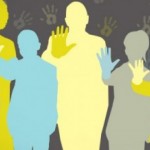
Warning: Illegal string offset 'output_key' in /nfs/bronfs/uwfs/hw00/d92/povblog/wordpress/wp-includes/nav-menu.php on line 604
Warning: Illegal string offset 'output_key' in /nfs/bronfs/uwfs/hw00/d92/povblog/wordpress/wp-includes/nav-menu.php on line 604
Warning: Illegal string offset 'output_key' in /nfs/bronfs/uwfs/hw00/d92/povblog/wordpress/wp-includes/nav-menu.php on line 604

The (Visual) Art of Contact
Sarah Elwood and Vicky Lawson, University of Washington, Department of Geography
A few weeks ago, Seattle’s Real Change organized this installation in Westlake Plaza, as part of their Outside In campaign for increased shelter capacity. 3123 pairs of shoes, representing the 3123 people sleeping outdoors on a cold January night in the 2014 One Night Count. The plaza buzzed with activity: Kiosks for signing the OutsideIn petition; people exploring and photographing the installation; distribution of free shoes; the occasional person exchanging one pair of shoes for another. Founding Director Tim Harris mentioned to us his surprise that the shoes became public art, calling it ‘the art of contact’. Here, he referenced Mary Louise Pratt’s Arts of the Contact Zone, a powerful source of inspiration for our thinking about poverty politics and cross-class alliance. Contact zones can prompt moments of interaction that foster insights about privilege and injustice, where people connect across differences in ways that upset their preconceptions about, for example, poverty and poorer people.
For us, the contact zone has been a captivating but elusive ideal. Truly transformative cross-class encounters are hard to find, arising mostly from intensive processes of reflective engagement, such as a years-long community planning forum we studied or weeks of intense classroom work. In the fleeting encounters of everyday life, we mostly see a cementing of people’s assumptions that middle class and poorer people are fundamentally different and that reinforce narratives that blame and shame poorer others.
Yet in the brief encounters at the shoe installation, something different was happening, prompted by the art of this contact zone. The vivid spectacle of 3123 shoes drew people in. As they looked, touched, and photographed, people in the plaza talked to one another. We overheard homeless and formerly homeless people talking to shoppers and tourists about cold feet, wet feet, weary feet and hurting feet – and the forces that produce them: The constant movement that comes from the policing of public space, banishment and trespass laws, the long walks after the end of downtown Seattle’s Ride Free Zone, the felt consequences of unaffordable health care. The transformative art of the shoes stems from their creative visual work – what they prompt us to see and ask. They invoke the common needs of the bodies we all inhabit, while also catalyzing questions about the different bodily vulnerability of more and less privileged people. They conjure an intimate sense of struggling feet without objectifying actual people in doing so.
The art of the shoes also transforms by disrupting, even briefly, the usual taken-for-granted rules of public space in urban America. On this afternoon countless people – the privileged and the impoverished – were “loitering” in the plaza, chatting, eating and drinking, sitting or lying on the sidewalks, feeding and playing with their dogs. In short, they were doing the things of everyday human life that are lightning rods for harassment, ejection, violence, citation and arrest when they are done by people perceived as homeless. The shoes produce a space in which something else is possible, something other than the tight policing of poverty that countless people assume is necessary to creating ‘safe’ and ‘attractive’ urban spaces. This contact zone shows us a different possible space in which all, not just the privileged, can do the things of ordinary human living.
Another recent encounter reminds us that the transformative art of contact also emerges in small interventions that shift how and what privileged people see. Over breakfast at a small hotel, I (Sarah) was talking with another guest. He enthused about taking up cycling in retirement and his favorite riverside path in Portland – it’s beautiful, he loves it, except for all the trash he sees. “It’s a mess,” he said, “shoes and clothes and trash and everything.” Silence. Then, my partner (a social worker) said, “You know, people live there. It’s their lives.” Another silence. Then a response that seemed to recognize that poverty and privilege radically differentiate experiences of the same space: “I guess you’re right,” said the cyclist, “for me, it’s just the place I ride.” The art of this simple intervention is a transformation of vision. Where this man once saw trash, he suddenly sees lives. As the conversation continued, he began to ask questions – what makes many of her clients homeless? How do social services help? What are the limits and problems with that help? Here, the art of the contact zone lies in an intervention that simply and powerfully shifts someone’s interpretive lens. It makes visible what privilege has obscured – that his riverside recreation is a space of precarious living for less privileged others.
Do these momentary encounters show us a fully transformed poverty politics or lasting insights into the interconnections of poverty and privilege? Of course not! Yet in each, the art of contact opens a space of possibility in which privileged actors can see differently, and from there, potentially know and engage differently. They suggest that momentary encounters can indeed change the stories we tell ourselves, the explanations we automatically turn to when we encounter poverty and difference.
What lessons might we take from these examples? In the everyday, be brave over breakfast! The simple statement “people live there” risks a moment of discomfort by demanding a different vision. But importantly, it plants a seed that stands to grow greater transformations. In activism, reclaim public space! These examples call us to re-engage the visual. We tend to be deeply (and appropriately) nervous about visual representations, worrying that they fix, distance, objectify, stereotype, lying wide open for misreading. As Jacques Ranciere reminds us “There is no straightforward road from the fact of looking at a spectacle to the fact of understanding the state of the world; no direct road from intellectual awareness to political action.” (The Emancipated Spectator, 2007, p. 75). Yet these examples remind us that a critical visual politics is possible, powerful, and necessary.






Leave a Reply